Ford Escape: Airbag Supplemental Restraint System (SRS)
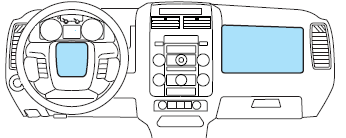
Important SRS precautions
The SRS is designed to work with the safety belt to help protect the driver and right front passenger from certain upper body injuries.
Airbags DO NOT inflate slowly; there is a risk of injury from a deploying airbag.
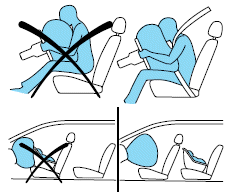
![]() WARNING: All occupants of the vehicle, including the driver,
should always properly wear their safety belts, even when an air
bag supplemental restraint system (SRS) is provided.
WARNING: All occupants of the vehicle, including the driver,
should always properly wear their safety belts, even when an air
bag supplemental restraint system (SRS) is provided.
![]() WARNING: When possible, all children 12 years old and under
should be properly restrained in a rear seating position.
WARNING: When possible, all children 12 years old and under
should be properly restrained in a rear seating position.
![]() WARNING: The National Highway Traffic Safety Administration
(NHTSA) recommends a minimum distance of at least 10 inches
(25 cm) between an occupant’s chest and the driver airbag module.
WARNING: The National Highway Traffic Safety Administration
(NHTSA) recommends a minimum distance of at least 10 inches
(25 cm) between an occupant’s chest and the driver airbag module.
![]() WARNING: Never place your arm over the airbag module as a
deploying airbag can result in serious arm fractures or other
injuries.
WARNING: Never place your arm over the airbag module as a
deploying airbag can result in serious arm fractures or other
injuries.
To properly position yourself away from the airbag:
• Move your seat to the rear as far as you can while still reaching the
pedals comfortably.
• Recline the seat slightly one or two degrees from the upright position.
![]() WARNING: Do not put anything on or over the airbag module.
WARNING: Do not put anything on or over the airbag module.
Placing objects on or over the airbag inflation area may cause those objects to be propelled by the airbag into your face and torso causing serious injury.
![]() WARNING: Do not attempt to service, repair, or modify the
airbag supplemental restraint systems or its fuses. Contact your
authorized dealer as soon as possible.
WARNING: Do not attempt to service, repair, or modify the
airbag supplemental restraint systems or its fuses. Contact your
authorized dealer as soon as possible.
![]() WARNING: Modifications to the front end of the vehicle,
including frame, bumper, front end body structure, tow hooks
and B-pillar surrounding parts may affect the performance of the
airbag sensors increasing the risk of injury. Do not modify the front
end of the vehicle.
WARNING: Modifications to the front end of the vehicle,
including frame, bumper, front end body structure, tow hooks
and B-pillar surrounding parts may affect the performance of the
airbag sensors increasing the risk of injury. Do not modify the front
end of the vehicle.
![]() WARNING: Additional equipment may affect the performance of
the airbag sensors increasing the risk of injury.
WARNING: Additional equipment may affect the performance of
the airbag sensors increasing the risk of injury.
Children and airbags
Children must always be properly restrained. Accident statistics suggest that children are safer when properly restrained in the rear seating positions than in the front seating position. Failure to follow these instructions may increase the risk of injury in a collision.
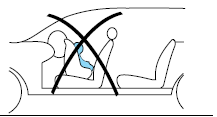
![]() WARNING: Airbags can kill
or injure a child in a child
seat. NEVER place a rear-facing
child seat in front of an active
airbag. If you must use a
forward-facing child seat in the
front seat, move the seat all the
way back.
WARNING: Airbags can kill
or injure a child in a child
seat. NEVER place a rear-facing
child seat in front of an active
airbag. If you must use a
forward-facing child seat in the
front seat, move the seat all the
way back.
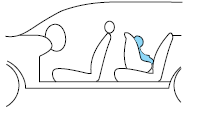
How does the airbag supplemental restraint system work?
The airbag SRS is designed to activate when the vehicle sustains a longitudinal deceleration sufficient to cause the airbag sensors to close an electrical circuit that initiates airbag inflation. The fact that the airbags did not inflate in a collision does not mean that something is wrong with the system. Rather, it means the forces were not sufficient enough to cause activation. Front airbags are designed to inflate in frontal and near-frontal collisions, not rollover, side-impact, or rear-impacts unless the collision causes sufficient longitudinal deceleration.
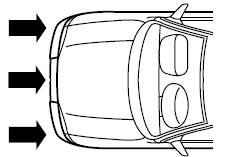
The airbags inflate and deflate rapidly upon activation. After airbag deployment, it is normal to notice a smoke-like, powdery residue or smell the burnt propellant. This may consist of cornstarch, talcum powder or sodium compounds which may irritate the skin and eyes, but none of the residue is toxic.
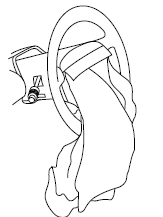
While the SRS is designed to help reduce serious injuries, contact with a deploying airbag may also cause abrasions, swelling or temporary hearing loss. Because airbags must inflate rapidly and with considerable force, there is the risk of death or serious injuries such as fractures, facial and eye injuries or internal injuries, particularly to occupants who are not properly restrained or are otherwise out of position at the time of airbag deployment. It is extremely important that occupants be properly restrained as far away from the airbag module as possible while maintaining vehicle control.
The SRS consists of:
• driver and passenger airbag modules (which include the inflators and
airbags).
• seat-mounted side airbags. Refer to Seat-mounted side airbag system
later in this chapter
• Safety Canopy System. Refer to Safety Canopy System later in this
chapter.
• one or more impact and safing sensors.
• Safety belt pretensioners
• a readiness light and tone.
• diagnostic module.
• and the electrical wiring which connects the components.
• Front passenger sensing system. Refer to Front passenger sensing
system later in this chapter.
• “Passenger airbag off” or “pass airbag off” indicator lamp. Refer to
Front passenger sensing system later in this chapter.
The RCM (restraints control module) monitors its own internal circuits and the supplemental airbag electrical system wiring (including the impact sensors, the system wiring, the airbag system readiness light, the airbag backup power and the airbag ignitors).
![]() WARNING: Several air bag system components get hot after
inflation. Do not touch them after inflation.
WARNING: Several air bag system components get hot after
inflation. Do not touch them after inflation.
![]() WARNING: If the airbag has deployed, the airbag will not
function again and must be replaced immediately. If the
airbag is not replaced, the unrepaired area will increase the risk of
injury in a collision.
WARNING: If the airbag has deployed, the airbag will not
function again and must be replaced immediately. If the
airbag is not replaced, the unrepaired area will increase the risk of
injury in a collision.
Front passenger sensing system
The front passenger sensing system is designed to meet the regulatory requirements of Federal Motor Vehicle Safety Standard (FMVSS) 208 and is designed to disable (will not inflate) the front passenger’s frontal airbag under certain conditions.
The front passenger sensing system works with sensors that are part of the front passenger’s seat and safety belt. The sensors are designed to detect the presence of a properly seated occupant and determine if the front passenger’s frontal airbag should be enabled (may inflate) or disabled (will not inflate).
The front passenger sensing system will disable (will not inflate) the front passenger’s frontal airbag if:
• the front passenger seat is unoccupied, or has small/medium objects in
the front seat,
• the system determines that an infant is present in a rear-facing infant
seat that is installed according to the manufacturer’s instructions,
• the system determines that a small child is present in a forward-facing
child restraint that is installed according to the manufacturer’s
instructions,
• the system determines that a small child is present in a booster seat,
• a front passenger takes his/her weight off of the seat for a period of
time,
Note: When the passenger airbag off light is illuminated, the passenger (seat mounted) side airbag may be disabled to avoid the risk of airbag deployment injuries.
The front passenger sensing system uses a passenger airbag off or pass airbag off indicator which will illuminate and stay lit to remind you that the front passenger frontal airbag is off. The indicator lamp is located in the center stack of the instrument panel just above the air vents.

Note: The indicator lamp will illuminate for a short period of time when the ignition is turned to the on position to confirm it is functional.
When the front passenger seat is not occupied (empty seat) or in the event that the front passenger frontal airbag is enabled (may inflate), the indicator lamp will be unlit.
The front passenger sensing system is designed to disable (will not inflate) the front passenger’s frontal airbag when a rear facing infant seat, a forward-facing child restraint, or a booster seat is detected.
• When the front passenger sensing system disables (will not inflate) the
front passenger frontal airbag, the indicator lamp will illuminate and stay
lit to remind you that the front passenger frontal airbag is disabled.
• If the child restraint has been installed and the indicator lamp is not
lit, then turn the vehicle off, remove the child restraint from the
vehicle and reinstall the restraint following the child restraint
manufacturer’s instructions.
The front passenger sensing system is designed to enable (may inflate) the front passenger’s frontal airbag anytime the system senses that a person of adult size is sitting properly in the front passenger seat.
• When the front passenger sensing system enables the front passenger frontal airbag (may inflate), the indicator will be unlit and stay unlit.
If a person of adult size is sitting in the front passenger’s seat, but the passenger airbag off or pass airbag off indicator lamp is lit, it is possible that the person isn’t sitting properly in the seat. If this happens:
• Turn the vehicle off and ask the person to place the seatback in the
full upright position.
• Have the person sit upright in the seat, centered on the seat cushion,
with the person’s legs comfortably extended.
• Restart the vehicle and have the person remain in this position for
about two minutes. This will allow the system to detect that person
and enable the passenger’s frontal airbag.
• If the indicator lamp remains lit even after this, the person should be
advised to ride in the rear seat.

![]() WARNING: Even with Advanced Restraints Systems, children
12 and under should be properly restrained in a rear seating
position.
WARNING: Even with Advanced Restraints Systems, children
12 and under should be properly restrained in a rear seating
position.
After all occupants have adjusted their seats and put on safety belts, it’s very important that they continue to sit properly. A properly seated occupant sits upright, leaning against the seat back, and centered on the seat cushion, with their feet comfortably extended on the floor. Sitting improperly can increase the chance of injury in a crash event. For example, if an occupant slouches, lies down, turns sideways, sits forward, leans forward or sideways, or puts one or both feet up, the chance of injury during a crash is greatly increased.
![]() WARNING: Sitting improperly out of position or with the seat
back reclined too far can take off weight from the seat cushion
and affect the decision of the front passenger sensing system, resulting
in serious injury or death in a crash.
WARNING: Sitting improperly out of position or with the seat
back reclined too far can take off weight from the seat cushion
and affect the decision of the front passenger sensing system, resulting
in serious injury or death in a crash.
Always sit upright against your seatback, with your feet on the floor.
The front passenger sensing system may detect small or medium objects placed on the seat cushion. For most objects that are in the front passenger seat, the passenger airbag will be disabled. Even though the passenger airbag is disabled, the pass airbag off lamp may or may not be illuminated according to the table below.


If you think that the status of the “passenger airbag off” indicator lamp is incorrect, check for the following:
• Objects lodged underneath the seat
• Objects between the seat cushion and the center console (if equipped)
• Objects placed on the front-passenger seat’s occupant’s lap
• Objects that may have trapped the safety belt against the seat or
passenger side b-pillar, preventing free movement of the safety belt
• Other passengers or cargo pushing or pulling on the seat’s bottom
cushion
• Rear seat passenger’s feet resting on or pushing on the seat’s bottom
cushion
The conditions listed above may cause the weight of a properly seated occupant to be incorrectly interpreted by the front passenger sensing system. The person in the front passenger seat may appear heavier or lighter due to the conditions described in the list above.
![]() WARNING: To reduce the risk of possible serious injury:
WARNING: To reduce the risk of possible serious injury:
Do not stow objects in seat back map pocket (if equipped) or
hang objects off seat back if a child is in the front passenger seat.
Do not place objects underneath the front passenger seat or between
the seat and the center console (if equipped).
Check the “passenger airbag off” or “pass airbag off” indicator lamp for
proper airbag Status.
Failure to follow these instructions may interfere with the front
passenger seat sensing system.
In case there is a problem with the front passenger sensing system, the airbag readiness lamp in the instrument cluster will stay lit.

If the airbag readiness lamp is lit, do the following:
The driver and/or adult passengers should check for any objects that may be lodged underneath the front passenger seat or cargo interfering with the seat.
If objects are lodged and/or cargo is interfering with the seat; please take the following steps to remove the obstruction:
• Pull the vehicle over.
• Turn the vehicle off.
• Driver and/or adult passengers should check for any objects lodged
underneath the front passenger seat or cargo interfering with the seat.
• Remove the obstruction(s) (if found).
• Restart the vehicle.
• Wait at least two minutes and verify that the airbag readiness lamp is
no longer illuminated
• If the airbag readiness lamp remains illuminated, this may or may/not
be a problem due to the front passenger sensing system.
DO NOT attempt to repair or service the system; take your vehicle immediately to an authorized dealer.
If it is necessary to modify an advanced front airbag system to accommodate a person with disabilities, contact the Ford Customer Relationship Center at the phone number shown in the Customer Assistance chapter of this Owner’s Guide.
![]() WARNING: Any alteration/modification to the front passenger
seat may affect the performance of the front passenger sensing
system.
WARNING: Any alteration/modification to the front passenger
seat may affect the performance of the front passenger sensing
system.
Determining if the system is operational
The SRS uses a readiness light in the instrument cluster or a tone to indicate the status of the system. Refer to Airbag readiness section in the Instrument Cluster chapter. Routine maintenance of the airbag is not required.
A difficulty with the system is indicated by one or more of the following:
• The readiness light will either
flash or stay lit.
• The readiness light will not
illuminate immediately after
ignition is turned on.

• A series of five beeps will be heard. The tone pattern will repeat periodically until the problem and/or light are repaired.
If any of these things happen, even intermittently, have the SRS serviced at an authorized dealer immediately. Unless serviced, the system may not function properly in the event of a collision.
Seat-mounted side airbag system
![]() WARNING: Do not place objects or mount equipment on or
near the airbag cover on the side of the seatbacks of the front
seats or in front seat areas that may come into contact with a
deploying airbag. Failure to follow these instructions may increase the
risk of personal injury in the event of a collision.
WARNING: Do not place objects or mount equipment on or
near the airbag cover on the side of the seatbacks of the front
seats or in front seat areas that may come into contact with a
deploying airbag. Failure to follow these instructions may increase the
risk of personal injury in the event of a collision.
![]() WARNING: Do not use accessory seat covers. The use of
accessory seat covers may prevent the deployment of the side
airbags and increase the risk of injury in an accident.
WARNING: Do not use accessory seat covers. The use of
accessory seat covers may prevent the deployment of the side
airbags and increase the risk of injury in an accident.
![]() WARNING: Do not lean your head on the door. The side airbag
could injure you as it deploys from the side of the seatback.
WARNING: Do not lean your head on the door. The side airbag
could injure you as it deploys from the side of the seatback.
![]() WARNING: Do not attempt to service, repair, or modify the
airbag SRS, its fuses or the seat cover on a seat containing an
airbag. See an authorized dealer.
WARNING: Do not attempt to service, repair, or modify the
airbag SRS, its fuses or the seat cover on a seat containing an
airbag. See an authorized dealer.
![]() WARNING: All occupants of the vehicle should always wear
their safety belts even when an airbag SRS is provided.
WARNING: All occupants of the vehicle should always wear
their safety belts even when an airbag SRS is provided.
How does the side airbag system work?
The design and development of the side airbag system included recommended testing procedures that were developed by a group of automotive safety experts known as the Side Airbag Technical Working Group. These recommended testing procedures help reduce the risk of injuries related to the deployment of side airbags.
The side airbag system consists of the following:
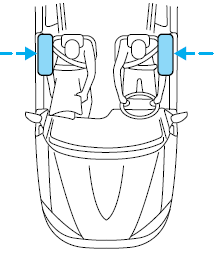
• An inflatable bag (airbag) with a
gas generator concealed behind
the outboard bolster of the driver
and front passenger seatbacks.
• A special seat cover designed to
allow airbag deployment.
• The same warning light, electronic control and diagnostic unit as used
for the front airbags.
• Two crash sensors located on the lower portion of the b-pillar (one on
each side of the vehicle).
Side airbags, in combination with safety belts, can help reduce the risk of severe injuries in the event of a significant side impact collision.
The side airbags are fitted on the outboard side of the seatbacks of the front seats. In certain lateral collisions, the airbag on the side affected by the collision will be inflated. The airbag was designed to inflate between the door panel and occupant to further enhance the protection provided occupants in side impact collisions.
The airbag SRS is designed to activate when the vehicle sustains lateral deceleration sufficient to cause the sensors to close an electrical circuit that initiates airbag inflation.
The fact that the airbags did not inflate in a collision does not mean that something is wrong with the system. Rather, it means the forces were not of the type sufficient to cause activation. Side airbags are designed to inflate in side-impact collisions, not roll-over, rear-impact, frontal or near-frontal collisions, unless the collision causes sufficient lateral deceleration.
![]() WARNING: Several airbag system components get hot after
inflation. Do not touch them after inflation.
WARNING: Several airbag system components get hot after
inflation. Do not touch them after inflation.
![]() WARNING: If the side
airbag has deployed, the
airbag will not function again.
WARNING: If the side
airbag has deployed, the
airbag will not function again.
The side airbag system (including the seat) must be inspected and serviced by an authorized dealer. If the airbag is not replaced, the unrepaired area will increase the risk of injury in a collision.
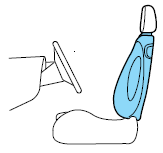
Determining if the system is operational
The SRS uses a readiness light in the instrument cluster or a tone to indicate the condition of the system. Refer to Warning lights and chimes in the Instrument Cluster chapter. Routine maintenance of the side airbag is not required.
A difficulty with the system is indicated by one or more of the following:
• The readiness light (same light as for front airbag system) will either
flash or stay lit.
• The readiness light will not illuminate immediately after ignition is
turned on.
• A series of five beeps will be heard. The tone pattern will repeat
periodically until the problem and/or light are repaired.
If any of these things happen, even intermittently, have the SRS serviced at your authorized dealer immediately. Unless serviced, the system may not function properly in the event of a collision.
Safety Canopy System
![]() WARNING: Do not place
objects or mount equipment
on or near the headliner at the
siderail that may come into
contact with a deploying Safety
Canopy . Failure to follow these
instructions may increase the risk
of personal injury in the event of a
collision.
WARNING: Do not place
objects or mount equipment
on or near the headliner at the
siderail that may come into
contact with a deploying Safety
Canopy . Failure to follow these
instructions may increase the risk
of personal injury in the event of a
collision.
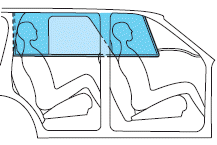
![]() WARNING: Do not lean your head on the door. The Safety
Canopy could injure you as it deploys from the headliner.
WARNING: Do not lean your head on the door. The Safety
Canopy could injure you as it deploys from the headliner.
![]() WARNING: Do not attempt to service, repair, or modify the
Safety Canopy System, its fuses, the A, B, or C pillar trim, or
the headliner on a vehicle containing a Safety Canopy . Contact your
authorized dealer as soon as possible.
WARNING: Do not attempt to service, repair, or modify the
Safety Canopy System, its fuses, the A, B, or C pillar trim, or
the headliner on a vehicle containing a Safety Canopy . Contact your
authorized dealer as soon as possible.
![]() WARNING: All occupants of the vehicle including the driver
should always wear their safety belts even when an airbag SRS
and Safety Canopy System is provided.
WARNING: All occupants of the vehicle including the driver
should always wear their safety belts even when an airbag SRS
and Safety Canopy System is provided.
![]() WARNING: To reduce risk of injury, do not obstruct or place
objects in the deployment path of the inflatable Safety Canopy
WARNING: To reduce risk of injury, do not obstruct or place
objects in the deployment path of the inflatable Safety Canopy
How does the Safety Canopy System work?
The design and development of the Safety Canopy system included recommended testing procedures that were developed by a group of automotive safety experts known as the Side Airbag Technical Working Group. These recommended testing procedures help reduce the risk of injuries related to the deployment of side airbags (including the Safety Canopy ).
The Safety Canopy system consists of the following:
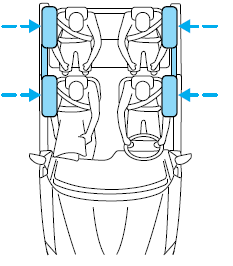
• An inflatable curtain with a gas
generator concealed behind the
headliner and above the doors
(one on each side of vehicle).
• A headliner designed to flex open
above the side doors to allow Safety Canopy deployment.
• The same warning light, electronic control and diagnostic unit as used
for the front airbags.
• Two crash sensors mounted at lower B-Pillar (one on each side).
• Two crash sensors located at the C-pillar behind the rear doors (one
on each side).
• Rollover sensor in the restraints control module (RCM).
The Safety Canopy system, in combination with safety belts, can help reduce the risk of severe injuries in the event of a significant side impact collision or rollover event.
Children 12 years old and under should always be properly restrained in the second or third row seats. The Safety Canopy will not interfere with children restrained using a properly installed child or booster seat because it is designed to inflate downward from the headliner above the doors along the side window opening.
The Safety Canopy system is designed to activate when the vehicle sustains lateral deceleration sufficient to cause the RCM to initiate Safety Canopy inflation or when a certain likelihood of a rollover event is detected by the rollover sensor.
The Safety Canopy is mounted to roof side-rail sheet metal, behind the headliner, above the first and second row seats. The Safety Canopy is designed to inflate between the side window area and occupants to further enhance protection provided in side impact collisions and rollover events.
The fact that the Safety Canopy did not activate in a collision does not mean that something is wrong with the system. Rather, it means the forces were not of the type sufficient to cause activation. The Safety Canopy is designed to inflate in certain side impact collisions or rollover events, not in rear impact, frontal or near-frontal collisions, unless the collision causes sufficient lateral deceleration or rollover likelihood.
![]() WARNING: Several Safety
Canopy system components
get hot after inflation. Do not
touch them after inflation.
WARNING: Several Safety
Canopy system components
get hot after inflation. Do not
touch them after inflation.
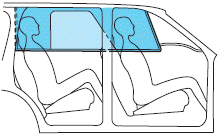
![]() WARNING: If the Safety Canopy system has deployed, the
Safety Canopy will not function again unless replaced. The
Safety Canopy system (including the A, B, C, and D pillar trim and
headliner) must be inspected and serviced by an authorized dealer. If
the Safety Canopy is not replaced, it will not function again, which will
increase the risk of injury in a future collision.
WARNING: If the Safety Canopy system has deployed, the
Safety Canopy will not function again unless replaced. The
Safety Canopy system (including the A, B, C, and D pillar trim and
headliner) must be inspected and serviced by an authorized dealer. If
the Safety Canopy is not replaced, it will not function again, which will
increase the risk of injury in a future collision.
Determining if the system is operational
The SRS uses a readiness light in the instrument cluster or a tone to indicate the condition of the system. Refer to Warning lights and chimes in the Instrument Cluster chapter. Routine maintenance of the side airbag is not required.
A difficulty with the system is indicated by one or more of the following:
• The readiness light (same light as for front airbag system) will either
flash or stay lit.
• The readiness light will not illuminate immediately after ignition is
turned on.
• A series of five beeps will be heard. The tone pattern will repeat
periodically until the problem and/or light are repaired.
If any of these things happen, even intermittently, have the SRS serviced at your authorized dealer immediately. Unless serviced, the system may not function properly in the event of a collision.
SOS Post-Crash Alert System™
The system automatically flashes the turn signal lamps and sounds the horn three times at four second intervals in the event of a serious impact that deploys an airbag (front, side, side curtain [if equipped] or Safety Canopy [if equipped]) or the safety belt pretensioners.
The system can be turned off when any one of the following actions are taken by the driver or any other person:
• pressing the hazard control button,
• or pressing the panic button on the remote entry transmitter.
The feature will continue to operate until the vehicle runs out of power.
Disposal of airbags and airbag equipped vehicles (includingpretensioners)
Contact your authorized dealer as soon as possible. Airbags MUST BE disposed of by qualified personnel.
See also:
Sunroof*
Sunroof
The sunroof can only be operated with the ignition switch in the “ON” position.
1- Open. 2- Tilt up. 3- Close, Tilt down.
To open, press the switch (1)
To stop the moving sunroof, press the switch (2) or (3).
NOTE:
● The su ...
Seats
Seats
- Do not ride in a moving vehicle
when the seatback is reclined. This
can be dangerous. The shoulder belt
will not be against your body. In an
accident, you could be thrown into it
and receive neck or other serious
injuries. Yo ...

 Safety Belt System
Safety Belt System